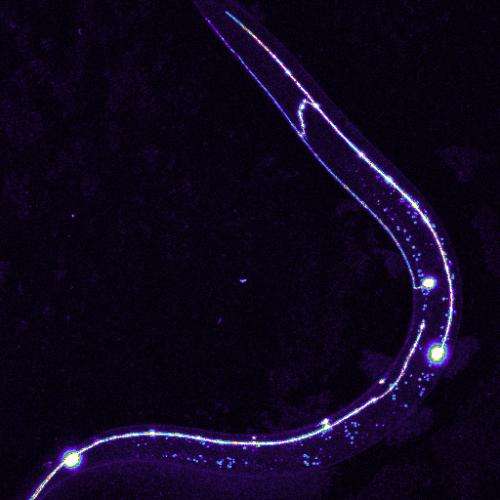Biologists uncover details of how we squelch defective neurons

Biologists at the University of California, San Diego have identified a new component of the cellular mechanism by which humans and animals automatically check the quality of their nerve cells to assure they're working properly during development.
In a paper published in this week's issue of the journal Neuron, the scientists report the discovery in the laboratory roundworm C. elegans of a "quality check" system for neurons that uses two proteins to squelch the signals from defective neurons and marks them for either repair or destruction.
"To be able to see, talk and walk, nerve cells in our body need to communicate with their right partner cells," explains Zhiping Wang, the lead author in the team of researchers headed by Yishi Jin, a professor of neurobiology in UC San Diego's Division of Biological Sciences and a professor of cellular and molecular medicine in its School of Medicine. "The communication is mediated by long fibers emitting from neurons called axons, which transmit electric and chemical signals from one cell to the other, just like cables connecting computers in a local wired network. In developing neurons, the journey of axons to their target cells is guided by a set of signals. These signals are detected by 'mini-receivers'—proteins called guidance receptors—on axons and translated into 'proceed,' 'stop,' 'turn left' or 'turn right.' Thus, the quality of these receivers is very important for the axons to interpret the guiding signals."
Jin, who is also an Investigator of the Howard Hughes Medical Institute, says defective protein products and environmental stress, such as hyperthermia, can sometimes jeopardize the health and development of cells. "This may be one reason why pregnant women are advised by doctors to avoid saunas and hot tubs," she adds.
The scientists discovered the quality check system in roundworms, and presumably other animals including humans, consists of two parts: a protein-cleaning machine containing a protein called EBAX-1, and a well-known protein assembly helper called heat-shock protein 90 known as "hsp90."
"Hsp90 facilitates the assembly of guidance receivers during the production and also fixes flawed products whenever they are detected," says Andrew Chisholm, a professor of neurobiology and cell and developmental biology, who also helped lead the study. "The EBAX-containing protein-cleaning machine is in charge of destroying any irreparable products so that they don't hang around and affect the performance of functional receivers. The EBAX-1 protein plays as a defectiveness detector in this machine and a connector to Hsp90. It captures defective products and presents them for either repair or destruction." A human neurodevelopmental disorder called "horizontal gaze palsy with progressive scoliosis" is associated with the defective production of one of the protein guidance receivers. This team of researchers showed that the defective human protein can interact with EBAX proteins. The authors hope that by investigating the action of EBAX-1 protein, their findings will provide clues to develop remedies or drugs to retreat human disorders in the future.















